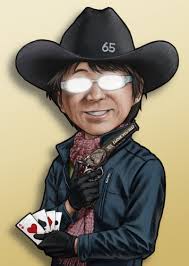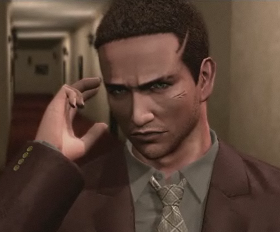Baffling, Fascinating & Intriguing: The Games of Hidetaka ‘Swery’ Suehiro
Can videogames be art? It seems like ten years ago that was all that you needed to say online in order to kick off an instant argument, one which usually broke down into a debate over the definition of “art”. Nowadays it’s generally agreed that some games can be art. (*Which* games is still an ongoing debate.) To create art, you need artists; people who bring a unique and visionary perspective to the medium. And there are few more unique than the man they call Swery.

Hidetaka Suehiro, better known as Swery65 [1] or Swery, didn’t originally study to enter the videogame industry. Instead he originally took a degree in film and advertising, something which might explain his attitude towards game design. He cut his teeth in his early 20s as a scenario writer for a pair of Neo Geo fighting games, then moved into design. In January of 2002 he got his first big break, after a group of developers he had met through his jobs decided to set up their own company. It was called Access Games, and it gave Swery his first ever chance to direct a video game.
That chance was with 2003’s Spy Fiction, a game best described as a Mission Impossible story told through a Metal Gear Solid lens. Superspies Billy Bishop and Sheila Crawford have to foil an evil organisation that is menacing the world, though of course twists and turns come along the way. The game was primarily created to target Western audiences, but ran afoul of two major factors. The first was just that Access Games couldn’t afford to advertise it enough to find it an audience. And the second was a late 2002 game called Splinter Cell. It redefined what people expected from a stealth espionage game, and so when Spy Fiction came out it already seemed dated. As a result it sank almost without a trace, becoming a hidden gem of the bargain bins.
Swery’s next game with Access was to be called Rainy Woods, and would have the protagonist play an FBI agent who arrived in a small American town in order to investigate the brutal murder of a high school girl. This may sound slightly familiar, and the trailer which debuted at the Tokyo Game Show in 2007 made it clear that this was at best heavily inspired by Twin Peaks. Before a lawsuit from David Lynch could arrive, technical difficulties led to the project being shelved. In the end it wasn’t released until 2010, and in between it received some changes that made its inspiration a little less obvious. Chief among those was a name change; and so the game that made Swery’s reputation was called Deadly Premonition.

To call Deadly Premonition a divisive game is to somewhat undersell it. In fact, with review scores at the time ranging from 2/10 up to 10/10 it literally holds the Guinness World Record for the most critically polarising survival horror game. Even describing it as “survival horror” is polarizing. When Francis York Morgan (the FBI agent protagonist) arrives in Greenvale, he does have to fight his way through a group of strange zombie-like creatures; but then they disappear back into the mists and the player instead finds themselves wandering around a beautifully realised American town. A town filled with many strange characters, and Francis York Morgan possibly the strangest of them all.
Part of what makes Deadly Premonition so unique is the approach that Swery and his team took to building the setting. Rather than create the town of Greenvale to fit the story, instead they built the town as a self-realised entity, and set the game in it. The result is a place that feels far more real than many more “realistic” games, exemplified by the beautiful horse farm that a player can stumble over in one corner of the map which plays absolutely no part in the game. It’s just there because it would be there if Greenvale was real, and so they put it there.

Deadly Premonition didn’t sell well enough to be financially successful on its first release, though it did earn Swery a cadre of devoted fans. (A later PC remaster sold much better.) This might be why Swery’s next big project needed a corporate tie-in. With the XBox One releasing in 2014, Microsoft decided that they wanted to gain attention by having Swery create an exclusive Kinect game for them. That game was D4: Dark Dreams Don’t Die, another story of an unconventional investigator. In this case it’s David Young, a man trying to solve his wife’s murder while unable to leave his apartment (in body, at least). Given the instruction to let himself go and give the people what they wanted, Swery created a game involving (among other things), time travel, a woman who might be a cat that David is hallucinating as a woman, and some very bad Boston accents. D4 was originally conceived as an episodic game (and eventually was released on Windows with mouse controls replacing the Kinect gimmick), but unfortunately Swery’s ill health meant that no further episodes would ever be released.

That ill health (reactive hypoglycemia) led Swery to retire for a few years, during which time he (among other things) became a Buddhist priest. He also gained a great many fans on Twitter during this time and became somewhat of a video games celebrity due to his affable demeanor and offbeat perspective. On recovering, he left Access Games and founded his own studio: White Owls. So far White Owls have two projects in the pipeline; a mystery game called The Missing and a “Debt Repayment Life Simulator” called The Good Life. This latter is about a woman named Naomi who moves to Rainy Woods, “the happiest town in the world”, in the hope of finding a way to pay off a massive debt she’s accumulated. This town, needless to say, has its own share of secrets to be discovered; including a gameplay twist that sees everyone (including Naomi) transform into animals at each full moon. Though Swery’s first attempt to crowdfund The Good Life on Fig failed, he’s currently back at it on Kickstarter and seems well on track to hit his goal. With his unique perspective still winning new fans, it’s easy to see why people are excited to see the next piece of art this Old Master creates.
[1] Despite what you might think from this handle, he was actually born in 1973.

